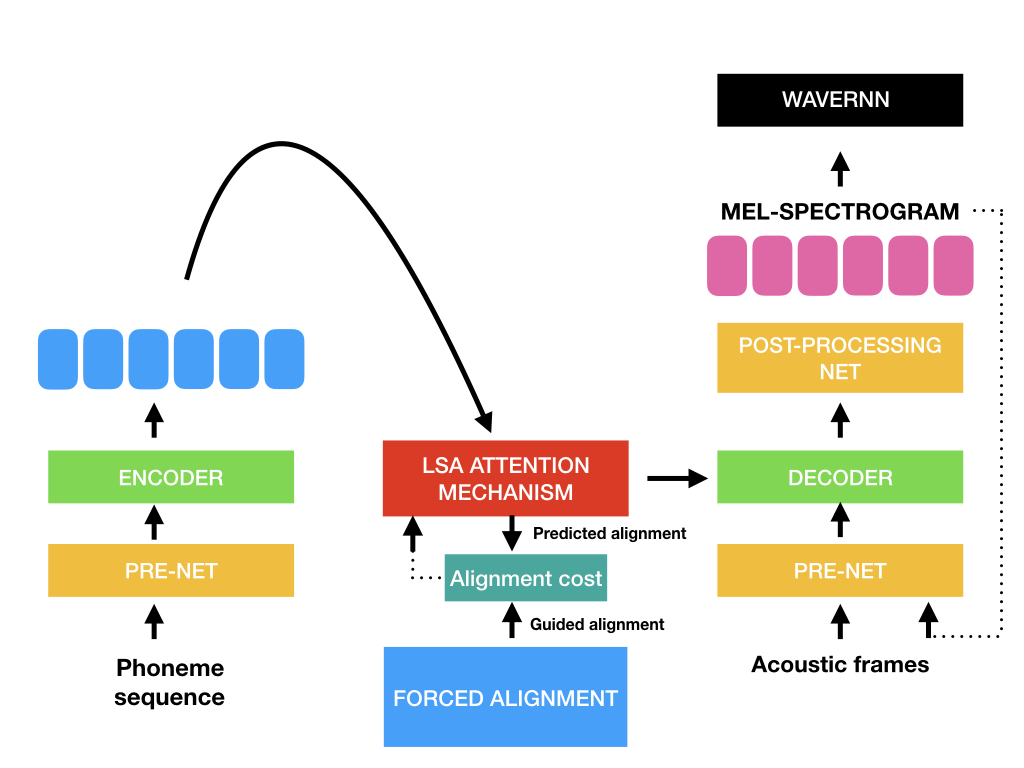A modified version of Fatchord/WaveRNN repository , which implements a variant of the system described in Tacotron: Towards End-to-End Speech Synthesis.
- Recipes for training Blizzard 2013 dataset (1, 2 or 4 books: JE, EM, LCL & FFM)
- Recipe to train model with pre-aligned guides as in Pre-Alignment Guided Attention for Improving Training Efficiency and Model Stability in End-to-End Speech Synthesis
Ensure you have:
- Python >= 3.6
- Pytorch 1 with CUDA
Install by creating a virtual environment using the following commands and install the the rest with pip:
conda create -n taco python=3.6 anaconda
conda install pytorch=1.0.1 torchvision cudatoolkit=8.0 -c pytorch
pip install -r requirements.txt
To test that everything is installed and working correctly run:
python quick_start.py --hp_file hp_JE.py
This will generate everything in the default phonemes.txt file and synthesize wavs which are saved in the 'quick_start' folder
Download the Blizzard Challenge 2013 wavs and Blizzard Challenge 2013 txt.
In the same wav directory, make sure you have the corresponding transcription/metadata file which looks like this:
audio || text | phoneme sequence
CB-JE-01-59||but Eliza just put her head in at the door, and said at once "She is in the window-seat, to be sure, Jack."|<START> b ah t <> ih l ay z ax <> jh ah s t <> p uh t <> hh er <> hh eh d <> ih n <> ae t <> dh ax <> d ao r <,> ae n d <> s eh d <> ae t <> w ah n s <> sh iy <> ih z <> ih n <> dh ax <> w ih n d ow <> s iy t <,> t ax <> b iy <> sh uh r <,> jh ae k <.> <END>
1 - Edit hparams.py or create new hparams eg., hp_JE.py
Edit the following parameters accordingly in hparams.py:
wav_path = 'data/wavs_train/'
data_path = 'data/CB_JE'
book_names = ['CB-JE']
voc_model_id = 'blizzard_vocoder'
tts_model_id = 'blizzard_baseline_JE'
metadata = "train.csv"
2 - Next run the following to perform feature extraction:
python preprocess.py --hp_file hp_JE.py
This extracts mels from wavs and dumps your linguistic features in a pickle file in the location specified by data_path in hparams.py.
To train the model:
3 - Train Tacotron using:
python train_tacotron.py --hp_file hp_JE.py
4 - To generate from the model:
Edit the autogen.sh script:
python test_taco_model_auto.py --checkpoint blizzard_baseline_JE.tacotron/taco_step300K_weights.pyt --model_name JE
This will generate the wavs using the test.txt phoneme sequences and save them in model_output.
Recipe to train model with pre-aligned guides
Currently there are 3 pretrained models available in the /pretrained/ folder':
Both are trained on Blizzard 2013:
- Tacotron trained using 1 book (JE) to 300k steps
- Tacotron trained using 4 books (that have wavs that have been carefully selected to control variability in speech rate) to 300k steps
- WaveRNN (Mixture of Logistics output) using LJSpeech trained to 800k steps (taken from original Fatchord/WaveRNN repo)
- Efficient Neural Audio Synthesis
- Tacotron: Towards End-to-End Speech Synthesis
- Natural TTS Synthesis by Conditioning WaveNet on Mel Spectrogram Predictions
- Pre-Alignment Guided Attention for Improving Training Efficiency and Model Stability in End-to-End Speech Synthesis
- https://github.com/fatchord/WaveRNN
- Special thanks to the CSTR at the University of Edinburgh who I was working for at the time that this code is written
